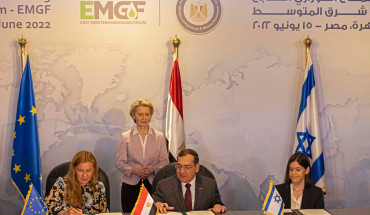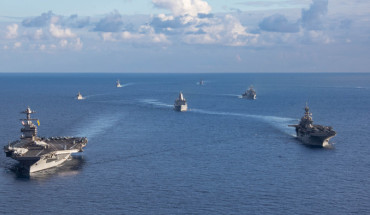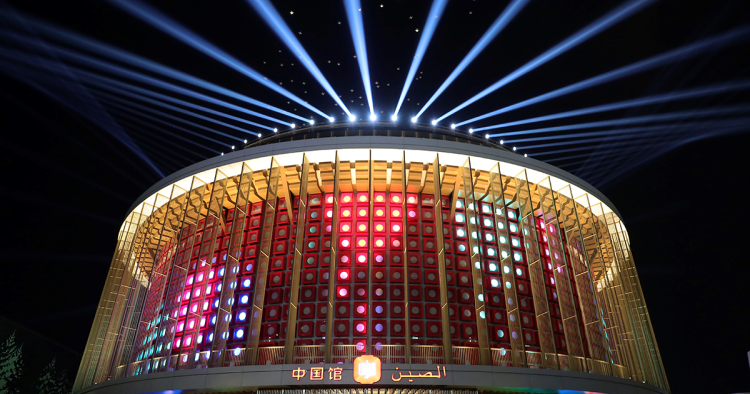Tensions between the United States and China are expanding beyond the Asia-Pacific region. The Middle East and North Africa is likely to be one of many venues in what might be a new Cold War between Washington and Beijing. We can imagine how Washington and Beijing’s respective global outlooks and ability to project (soft and hard) power could affect their future relations with the MENA region. How MENA countries deal with each other, and the role they play in the emerging global energy and economy transitions, could influence how the two superpowers engage with the region in ways as interesting and important as what the superpowers are able to do themselves.
Three factors shaping the future
On the MENA side of the equation, two critical dimensions are likely to shape their role in the future US-China competition in the region.
(1) Intraregional politics: The first is how regional countries relate to each other: with functional and practical economic and political integration, or sustained dysfunction and instability. Prior to the current war in Gaza, there was a trend toward de-escalation, stabilization, and integration. Whenever that momentum might be regained, under the “functional and practical” route, we could imagine MENA nations looking in new ways at the lessons of pan-regional intergovernmental organizations. The region could explore policies and mechanisms that emulate the practical benefits afforded to member states of other regional blocs like the European Union and the Association of Southeast Asian Nations. Such ideas could first lower trade barriers, then foster closer economic and commercial ties across the region.
Similarly, the thinking behind the Helsinki Final Act of 1975 and the Organization for Cooperation and Security in Europe could influence MENA governments’ approach to their citizens’ human rights and each other’s domestic affairs.
The functional and practical path would represent a MENA equipped with deliberative, consultative decision-making processes to act with agency, putting its own interests before the dictates of the US-Chinese competition.
The alternative path is easy to define: MENA governments continue to support various armed groups in proxy wars, and use that environment to ignore human rights, enabling outside players to exploit that dysfunction.
(2) Levers of the future economy: The fossil fuel resources of Bahrain, Iran, Iraq, Kuwait, Libya, Oman, Qatar, Saudi Arabia, and the United Arab Emirates (that energy-rich club might soon include Egypt and Israel) are likely to remain MENA’s main sources of leverage vis-à-vis Washington and Beijing — at least for the next couple of decades. Given the two superpowers’ desire to secure the region’s oil and gas for themselves and their allies (or deny them to adversaries), US and Chinese companies will remain powerhouses in regional markets.
But MENA is poised to influence the future global stage, and gain agency in the US-China competition over the region, by leveraging its energy and financial power in different ways in the future. As the world turns to renewable energy, the region’s petrostates are simultaneously ramping up economic diversification into tech sectors while also leveraging their wealth to finance climate-friendly energy projects and other green economy endeavors in their neighborhood and around the world. The new frontier for the region’s resource- and capital-rich countries will be fostering innovation and science/technology/ideas hubs for the post-carbon economy that humanity intends to build in the 21st century.
Beside eventually waning hydrocarbons and ascending green energy, new logistical/transportation/energy networks have proliferated in the region and are likely to further increase its geopolitical and commercial significance. Be it through long-established routes, such as the Suez Canal, or new and proposed ones, such as the Trans-Caspian International Transport Route, India-Middle East Corridor, and the Turkish-Iraqi-Emirati-Qatari Development Road, MENA is going to be sitting at the center of global trade networks. Many of the region’s seaports and airports will also play an expanded role in international affairs.
(3) An eagle and a dragon walk into a bazaar — Fit or floundering?: When Donald Trump became president in 2017, he opened to question the wisdom of international trade as a net positive while putting the US on a more confrontational path against China, globally, to include MENA. China, of course, had already started moving into MENA more forcefully in the late 2010s. Beijing’s successful mediation between Iran and Saudi Arabia to resume diplomatic relations in 2023 caught many by surprise but that was only the latest in a series of Chinese advances in the region.
At the same time, unrelated issues have increasingly complicated the ability of both countries to compete as they might prefer. Some analysts argued that the demographic bottlenecks and economic woes facing the People’s Republic would prevent it from competing with the United States and the West before a new Cold War could even begin. In the US case, its own economic issues, and increasingly polarized domestic politics and their ripple effects, are constraints.
Ironically, their respective struggles risk undermining what are perhaps among the strongest factors that could help in determining US and Chinese relations with the MENA region. For the United States, its cultural nodes, as well as its freedom and rule of law, likely appeal to the region’s restive youth but are showing strains. For China, its successful experience in rapid socioeconomic transformation in two generations without any noticeable changes to its political system may be its main selling point to at least some MENA governments, but that, too, is showing strains for Beijing.
An important new factor is how much MENA countries have shown their intention in the last few years to forge a path not beholden to either superpower — in part because they see Washington’s and Beijing’s foibles. There are many examples: Iran’s and Saudi Arabia’s decision, along with the United Arab Emirates, Egypt, and Ethiopia, to join the BRICS group of nations (Brazil, Russia, India, China, and South Africa) in August 2023 is only one of the most recent ones, raising eyebrows in the West. Many came to question whether BRICS and MENA were beginning to form an anti-Western bloc, despite denials of a turn away from the West.
What might the US-China competition in MENA look like in the future if the countries there take the more functional and practical path in intra-regional relations and lean into the green energy/economy transition, while the superpowers contend with internal challenges?
Scenario 1: US strong, China as weaker outlier
The United States stabilized at home after the 2032 election. Through a mix of economic protectionism against adversaries, openness to commerce with allies, gains in labor rights and skills, and cooling off societal tensions, America had a resurgence reminiscent of the 1980s and 1990s at home and abroad.
Washington found smarter ways than “boots on the ground” in MENA. Successive US administrations mixed pressure and incentives to allies to help them resolve their long-standing disputes through confidence-building measures. An engaged Washington could support entities that encourage regional cooperation. With that support, many US-friendly MENA countries lowered their trade barriers and cooperated on conventional and renewable energy projects. That made the support increasingly a two-way street over time, as emerging MENA tech sector powers supplied an increasing share of the growing markets in the US for green economy products and projects.
China did not sit idly by though. It continued to invest in Iran as well as Gulf Arab nations for energy security while selling them weapons. Still, Beijing could not fulfill its purported potential as envisioned in the early 21st century. It increased its influence over Iran (and Syria and Iraq) by other means, and the Islamic Republic became a major geopolitical outpost for the People’s Republic. However, China’s attempts to benefit from remaining geopolitical and factional tensions in the region at US expense yielded limited results.
Part of the problem rested with Beijing’s limited capacity to respond to the region’s needs. Belt and Road Initiative (BRI) projects either proved unprofitable or unable to alleviate MENA countries’ infrastructure problems. Thus, leaders in MENA capitals paid more attention to their American and European options — and leveraged their own tech capabilities to build for themselves. China’s demographic and economic bottlenecks, along with geopolitical problems in its near abroad, further barred meaningful engagement with the MENA region.
Scenario 2: United States stagnant, China strong
Unlike the first scenario, America’s domestic scene never calms down, hampering its ability to project power as it once did. Washington’s woes — monetary and fiscal policies at the federal level (or lack thereof), inability to retrain its labor force, and contentious politics around wealth and income inequalities, identity, and “America First” — diminish US political influence and the preeminence of the dollar.
This relative US weakness, and the lack of consistency in the policies of successive administrations, make regional countries prefer to conduct business with Beijing. US allies such as Israel, Turkey, and Egypt remain tethered to the West politically and economically, though they, too, balance their relations between the West and the East.
A more functional MENA, with its intra-regional trade and its investment in exportable renewable energy and green industries accelerating, finds its engagement with China deepening as Beijing begins to shift to greening its economy. The region’s trade with Beijing and the wider Asia-Pacific region doubles from the 2010s to the 2030s and again by the late 2040s, and MENA countries vote along similar lines as China at the UN and the World Trade Organization. These positive dynamics outweighed any concerns that Beijing continues to ally with Iran.
Friendship with Beijing is paying off for the region’s political elites as well as its citizens, but on a much more co-equal footing than in past decades. One result is a bolstering of commerce within the region as well as with China and the rest of Asia. Some countries use Beijing-sponsored BRI initiatives to upgrade their physical infrastructure, while regional industrial powerhouses such as Turkey and Egypt and newly “green-industrialized” economies such as Jordan, Palestine, and Iraq are becoming more able to produce high-quality widgets that compete with Chinese goods.
Scenario 3: "Compeer-itition"
Here, both the United States and China have regained their “mojo” by the middle of the 21st century. And the MENA states, with better educated and trained populations, GDP growth, investment in the green economy, and influence over global trade, transportation, and logistics routes, stand collectively as a near-peer vis-à-vis the two superpowers.
This has had much to do with intra-regional changes. Functional integration helped unlock tens of billions of dollars in economic and commercial value. As industrialized countries lessened their dependence on oil and gas, the hydrocarbon-rich countries of the MENA region offered lucrative purchase and carry options for developing countries in Asia and Africa — and used the proceeds to invest in high-efficiency wind and solar energy technologies, green hydrogen, smart grids, and new-generation desalination plants, which it then offered to both industrialized and developing countries at competitive rates.
MENA’s relations with the US and China rest on a healthy mix of cooperation and competition. Coupling Gulf money with engineering giants from Asia, MENA, and North America helped to build resilient infrastructure in countries vulnerable to rising sea levels and other risks posed by climate change. At the same time, Abu Dhabi, Doha, Dubai, Istanbul, Riyadh, and Tel Aviv came to compete with China’s and America’s finance and tech hubs in the development of technologies that fight climate change. These dynamics effectively dampened any lingering US and Chinese interest in a Cold War with each other in MENA.
Epilogue: A new slant on the US and China in the Middle East
Today, as MENA’s headline-producing problems persevere and worsen, the United States and China are able to compete to influence regional governments according to their own priorities. If we — and more importantly, leaders in the region — take the time to imagine futures in which countries take on bold new forms of agency to reset intraregional political dynamics, and to invest in the tech and green economies of the future, we can see the kinds of steps that could create those futures and temper Washington and Beijing’s competition in this part of the world.
Barın Kayaoğlu is the Dean of Students and Associate Professor of World History at the American University of Iraq, Sulaimani (AUIS) and a non-resident fellow with the Strategic Foresight Initiative at the Middle East Institute. The opinions expressed in his works are personal and not shared by AUIS or MEI.
Steven Kenney is the director of MEI’s Strategic Foresight Initiative and the founder and principal of Foresight Vector LLC.
Photo by Wang Dongzhen/Xinhua via Getty Images
The Middle East Institute (MEI) is an independent, non-partisan, non-for-profit, educational organization. It does not engage in advocacy and its scholars’ opinions are their own. MEI welcomes financial donations, but retains sole editorial control over its work and its publications reflect only the authors’ views. For a listing of MEI donors, please click here.













